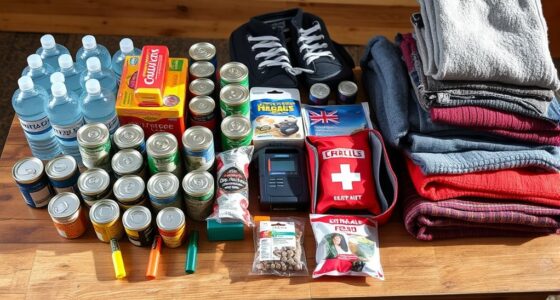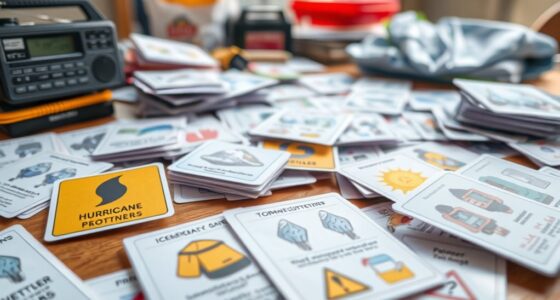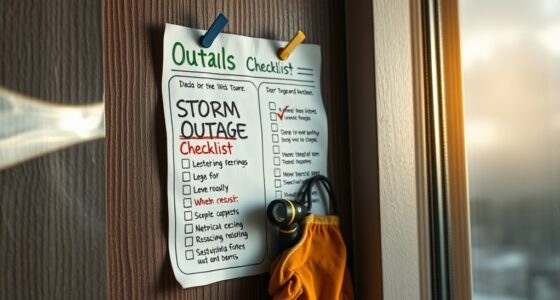During power outages, it’s vital you have a clear communication strategy to keep everyone safe and informed. Use social media to share updates, but make sure your devices are charged and backup plans like battery radios are ready. Create a list of trusted contacts and official sources to verify info quickly. Combining social media, texts, and community alerts helps cover gaps if power or internet drops. To guarantee you’re fully prepared and can respond effectively, continue exploring these essential steps.
Key Takeaways
- Develop a multi-channel communication plan combining social media, radio, text alerts, and community networks.
- Identify and verify trusted sources for accurate, real-time updates to prevent misinformation.
- Prepare devices with full batteries and portable chargers to maintain connectivity during outages.
- Establish predefined protocols for family, neighbors, and colleagues to ensure coordinated information sharing.
- Incorporate backup communication methods like battery-powered radios and community alert systems for redundancy.

During a power outage, effective communication becomes essential to guarantee safety and keep everyone informed. When the lights go out unexpectedly, your ability to share accurate information quickly can make a significant difference in how the situation unfolds. This highlights the importance of emergency preparedness, which includes having a clear communication plan in place. Being prepared means knowing in advance how you’ll reach family members, neighbors, or colleagues and what channels you’ll use to disseminate critical updates. It’s important to identify reliable sources of information and establish a strategy that ensures everyone stays connected, even when traditional means like phone lines or internet services are disrupted.
Social media communication plays an important role in your emergency preparedness plan. Platforms like Twitter, Facebook, or Instagram can serve as rapid, accessible tools for sharing updates, safety instructions, and reassurance. When the power’s out, internet-based communication often remains functional longer than traditional methods, especially if you have backup power supplies or mobile data. Using social media allows you to reach a broad audience quickly, providing real-time updates about the outage’s scope, estimated restoration times, and safety tips. Keep in mind that social media can spread misinformation if not managed carefully. To avoid this, verify information before posting and rely on official sources, such as local utility companies, emergency services, or government agencies.
Incorporating social media into your emergency preparedness also involves planning ahead. Create a list of trusted contacts and official accounts to follow for updates. Set up alerts for relevant pages to receive notifications instantly. Make sure your devices are charged and that you have portable chargers ready, so you can stay connected even if the power is out for an extended period. Encourage your family or coworkers to do the same, and establish a communication protocol that includes social media updates alongside traditional methods like text messages or radio broadcasts. Additionally, understanding the limitations of social media can help you develop a more comprehensive emergency plan, ensuring all communication channels are covered.
During a power outage, you should also be aware of the limitations of social media communication. Not everyone may have internet access or a smartphone, so it’s important to have backup plans, such as battery-powered radios, community alert systems, or neighborhood watch groups. Combining these methods with social media communication ensures an all-encompassing approach to emergency preparedness. The key is to use social media strategically—sharing timely, accurate information that helps everyone stay safe and informed. With proper planning and a clear communication strategy, you can navigate power outages more effectively, minimizing confusion and ensuring your community remains resilient in challenging situations.
Frequently Asked Questions
How Can I Charge My Phone Without Electricity?
You can charge your phone without electricity by using solar chargers or portable batteries. Solar chargers harness sunlight and provide a sustainable way to power your device outdoors. Portable batteries, also known as power banks, store energy that you can use anytime, anywhere. Simply connect your phone to these devices, and you’ll stay connected even during power outages. Keep these tools charged and ready for reliable, on-the-go power.
What Alternative Communication Methods Are Recommended During Outages?
During outages, you should consider using ham radios and satellite communication devices. Ham radios let you connect with others locally or internationally without relying on power grids, especially if you have a backup power source. Satellite communication devices enable you to send messages or make calls from remote areas where cell service isn’t available. Keep these tools charged and ready, so you’re prepared to stay connected when traditional methods fail.
How Do I Inform Neighbors About Power Outage Updates?
You should use neighbor notifications and community alerts to inform your neighbors about power outage updates. Share information through text messages, social media groups, or neighborhood apps to guarantee everyone stays informed quickly. Consider posting notices in common areas or door-to-door if digital methods aren’t effective. Keeping neighbors updated fosters community support and helps everyone stay safe until power is restored.
Are There Specific Apps for Emergency Alerts During Outages?
Yes, you can use emergency alert apps like FEMA or local government apps to stay informed during outages. Additionally, consider investing in solar-powered radios, which provide reliable updates even without power. These tools help you receive real-time alerts, weather updates, and safety instructions, ensuring you’re always aware of the situation. Combining emergency alert apps with solar radios offers a robust communication strategy during power outages.
What Should I Include in an Emergency Communication Kit?
Prepare a practical, portable emergency kit packed with power supplies, like backup batteries, to guarantee long-lasting battery life. Include a reliable radio, flashlight, and a charger for your devices. Make sure your messages are clear and concise to avoid confusion. Keep essential items like water, snacks, and important documents handy. This kit keeps you prepared, protected, and able to communicate confidently during power outages.
Conclusion
In times when the lights are dim, a well-planned communication strategy keeps everyone connected. By staying calm, sharing updates gently, and using trusted channels, you help your community navigate the quiet moments smoothly. Remember, even in the darkness, your words can be the guiding star. Embrace patience and clarity, turning a pause into an opportunity for understanding. With thoughtful communication, you’ll guarantee everyone feels informed, reassured, and united until the power returns.








